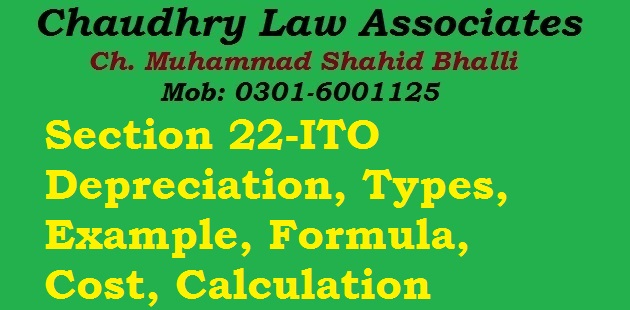Section 22 ITO 2001, Depreciation in Income Tax Ordinance 2001 and as per Lawkidunya, the word Depreciation is an accounting method of allocating the cost of a tangible or physical asset over its useful life or life expectancy. Depreciation represents how much of an asset’s value has been used up. For example, companies can take a tax deduction for the cost of the asset, meaning it reduces taxable income.
Depreciation in Income Tax Ordinance 2001
Section 22 ITO 2001 Depreciation is Subject to this section, a person shall be allowed a deduction for the depreciation of the person’s depreciable assets used in the person’s business in the tax year.
(2) Subject to 3[sub-section (3) 4, the depreciation deduction for a tax year shall be computed by applying the rate specified in Part I of the Third Schedule against the written down value of the asset at the beginning of the year.
(3) Where a depreciable asset is used in a tax year partly in deriving income from business chargeable to tax and partly for another use, the deduction allowed under this section for that year shall be restricted to the fair proportional part of the amount that would be allowed if the asset 5[was] wholly used to 6[derive] income from business chargeable to tax.
(5) The written down value of a depreciable asset of a person at the beginning of the tax year shall be —
(a) where the asset was acquired in the tax year, the cost of the asset to the person as reduced by any initial allowance in respect of the asset under section 23; or
(b) in any other case, the cost of the asset to the person as reduced by the total depreciation deductions (including any initial allowance under section 23) allowed to the person in respect of the asset in previous tax years. building, furniture, plant or machinery is used for the purposes of business during any tax year for which the income from such business is exempt, depreciation admissible under sub-section (1) shall be treated to have been allowed in respect of the said tax year and after expiration of the exemption period, written down value of such assets shall be determined after reducing total depreciation deductions (including any initial allowance under section 23) in accordance with clauses (a) and (b) of this sub-section.”
(6) Where sub-section (3) applies to a depreciable asset for a tax year, the written down value of the asset shall be computed on the basis that the asset has been solely used to derive income from business chargeable to tax.
(7) The total deductions allowed to a person during the period of ownership of a depreciable asset under this section and section 23 shall not exceed the cost of the asset.
(8) Where, in any tax year, a person disposes of a depreciable asset, no depreciation deduction shall be allowed under this section for that year and —
(a) if the consideration received exceeds the written down value of the asset at the time of disposal, the excess shall be chargeable to tax in that year under the head “Income from Business”; or
(b) if the consideration received is less than the written down value of the asset at the time of disposal, the difference shall be allowed as a deduction in computing the person’s income chargeable under the head “Income from Business” for that year.
(9) Where sub-section (3) applies, the written down value of the asset for the purposes of sub-section (8) shall be increased by the amount that is not allowed as a deduction as a result of the application of sub-section (3).
(10) Where clause (a) of sub-section (13) applies, the 2[consideration received on disposal] of the passenger transport vehicle for the purposes of sub-section (8) shall be computed according to the following formula —
What is the Depreciation in Accounting
Depreciation is an accounting method of allocating the cost of a tangible or physical asset over its useful life or life expectancy. Depreciation represents how much of an asset’s value has been used up. For example, companies can take a tax deduction for the cost of the asset, meaning it reduces taxable income.
What are the 3 Depreciation Methods
Various Depreciation Methods
Straight Line Depreciation Method.
Diminishing Balance Method.
Sum of Years’ Digits Method.
Double Declining Balance Method.
Sinking Fund Method.
Annuity Method.
Insurance Policy Method.
Discounted Cash Flow Method.
What you mean by Depreciation
The monetary value of an asset decreases over time due to use, wear and tear or obsolescence. This decrease is measured as depreciation. Machinery, equipment, currency are some examples of assets that are likely to depreciate over a specific period of time.
What is Depreciation and how is it calculated
The formula is: Depreciation = 2 * Straight line depreciation percent * book value at the beginning of the accounting period. Book value = Cost of the asset – accumulated depreciation. Accumulated depreciation is the total depreciation of the fixed asset accumulated up to a specified time.

